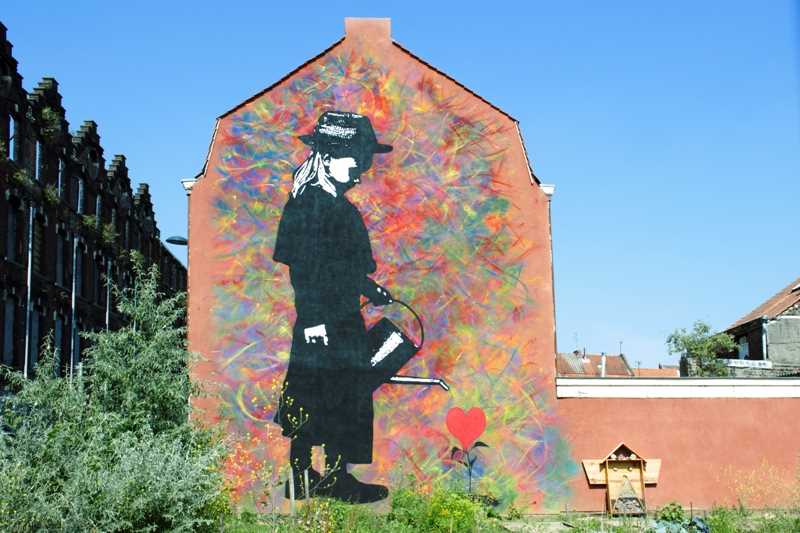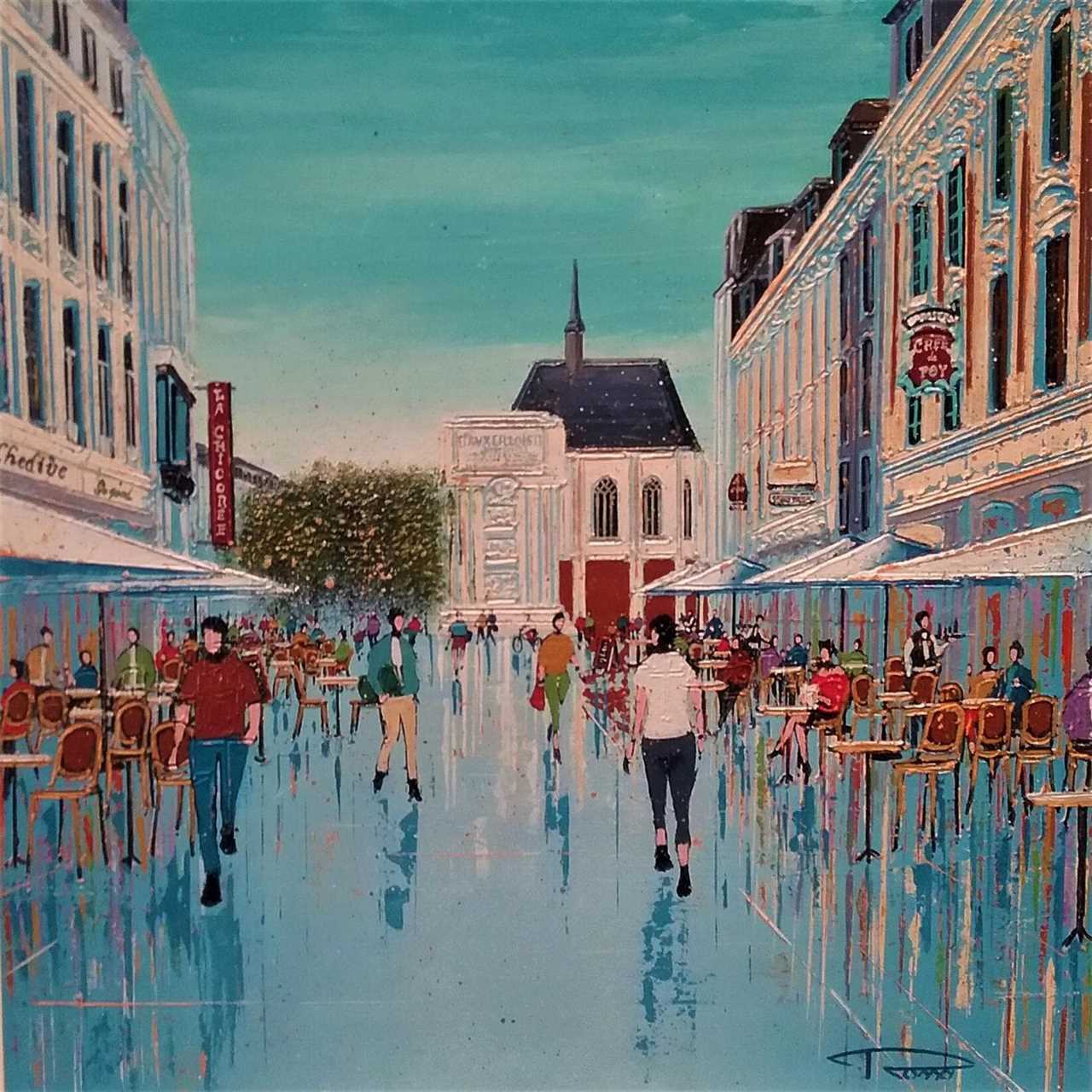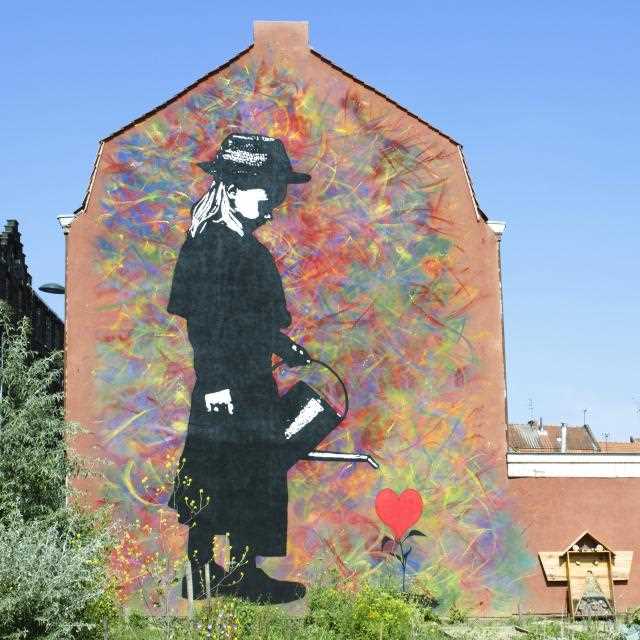
Lille, a vibrant city in northern France, is home to a thriving street art scene that has transformed its urban landscape into a colorful and dynamic canvas. From towering murals to hidden alleyway artwork, street art has become an integral part of Lille’s identity and a reflection of its vibrant cultural tapestry.
Street art in Lille is not just about graffiti tags and spray-painted walls; it is a carefully curated form of artistic expression that showcases the talent and creativity of local artists. These artists use the city as their canvas, adorning its walls with stunning visuals and thought-provoking messages that reflect the social, political, and cultural issues of our time.
Walking through the streets of Lille is like embarking on an open-air art exhibition. Every corner you turn, every alley you explore, reveals a new masterpiece waiting to be discovered. From the historic streets of Vieux Lille to the modern boulevards of Euralille, street art has found its place in every nook and cranny of the city.
What makes the street art scene in Lille truly remarkable is its inclusivity and accessibility. Street art is not confined to the walls of prestigious galleries; it is free for everyone to admire and enjoy. This democratic approach to art allows the people of Lille and visitors alike to engage with and appreciate the artistic expression that adorns their city.
The History of Street Art in Lille
Lille, a vibrant city in northern France, has a rich and colorful history of street art. From its origins as a mining and industrial town, Lille has transformed into a hub of creativity and artistic expression. Over the years, street art has become an integral part of Lille’s urban landscape, transforming blank walls into colorful canvases and adding a touch of artistic flair to the city.
The Origins
The roots of street art in Lille can be traced back to the 1980s when graffiti first started appearing on the city’s walls. Influenced by the emerging hip-hop culture and the graffiti scenes of New York and Paris, local artists began using spray paint to leave their mark on the city. What started as an act of rebellion quickly evolved into a powerful form of artistic expression.
Growth and Recognition
In the 1990s, street art in Lille began to gain recognition as a legitimate art form. Local artists started organizing exhibitions and events to showcase their work, attracting attention from art enthusiasts and critics alike. The city government also played a crucial role in supporting and promoting street art, providing legal spaces for artists to create their murals and even commissioning large-scale public art installations.
The Lille Street Art Festival
One of the defining moments for street art in Lille was the establishment of the Lille Street Art Festival in 2004. This annual event brings together local and international artists to create new murals and installations across the city. The festival has become a platform for artists to showcase their talent, exchange ideas, and push the boundaries of street art.
| Year | Artist | Location |
|---|---|---|
| 2005 | Banksy | Rue Faidherbe |
| 2008 | Invader | Euralille |
| 2012 | Ella & Pitr | Place des Buisses |
| 2015 | ROA | Rue de la Clef |
Street Art Tours
Today, street art has become an integral part of Lille’s cultural fabric, attracting visitors from all over the world. Guided street art tours have also become popular, allowing visitors to explore the city’s vibrant street art scene and learn about the artists and their works. These tours provide a unique insight into the history, techniques, and stories behind Lille’s street art.
The Different Styles of Street Art

Street art is a vibrant form of artistic expression that can be found in cities all around the world. It encompasses various styles and techniques, each with its own unique characteristics and messages. Here are some of the different styles of street art:
1. Graffiti

Graffiti is perhaps one of the most popular and well-known styles of street art. It involves the use of spray paint to create large, colorful murals or tags on public surfaces such as walls and buildings. Graffiti artists often use bold and vibrant colors to make a statement or display their artistic skills. While graffiti is often considered illegal, it has become more accepted and appreciated as a form of urban art.
2. Stencils
Stencil art is another popular style of street art that involves creating images by cutting out shapes or patterns on a stencil and then spraying paint or ink through the stencil onto a surface. This technique allows artists to create detailed and precise artwork with ease. Stencil art can range from simple designs to intricate and multi-layered compositions.
3. Wheatpasting
4. Stickers

Sticker art involves creating small adhesive stickers with designs or messages and sticking them onto public surfaces. This style of street art is often used as a form of self-expression or as a means of spreading a particular message or idea. Sticker artists usually create large quantities of stickers and distribute them widely, turning the city into their personal gallery.
These are just a few of the many styles of street art that can be found in cities like Lille. Each style brings its own unique flair and perspective to the urban landscape, turning the city into a colorful canvas for artistic expression.
Street Art Festivals and Events

Street art festivals and events play a crucial role in promoting and celebrating the vibrant urban art scene in Lille. These events bring together artists, locals, and tourists to experience the city’s street art culture in a dynamic and interactive way.
Urban Art Festival
The Urban Art Festival is a highly anticipated annual event that showcases local and international street artists. This festival transforms the streets of Lille into an open-air gallery, with walls, buildings, and even bridges becoming the canvas for artistic expression. Visitors can observe artists in action as they create awe-inspiring murals and graffiti pieces, adding a touch of color and creativity to the cityscape.
Mural Tours

In addition to festivals, there are also guided mural tours available in Lille. These tours provide a unique opportunity to explore the city’s street art scene under the guidance of knowledgeable local guides. Participants can discover hidden gems and learn about the history, techniques, and stories behind the artworks. It’s a fantastic way to delve deeper into the world of street art and gain a deeper appreciation for the artists and their work.
Whether you’re a street art enthusiast or simply curious about urban art, Lille’s street art festivals and events offer an immersive and captivating experience. They provide a platform for artists to showcase their talent, encourage dialogue and cultural exchange, and contribute to the city’s artistic and creative identity.
The Impact of Street Art on Lille’s Culture and Identity

Street art has had a profound impact on the culture and identity of the city of Lille. The vibrant and colorful murals that adorn the walls of the cityscape have become an integral part of Lille’s artistic heritage. They not only beautify the urban environment but also serve as a powerful means of self-expression for the artists and a platform for social commentary.
One of the ways street art has influenced Lille’s culture is by attracting tourists and visitors who are drawn to the city’s vibrant art scene. These colorful artworks have become iconic landmarks and have helped put Lille on the map as a destination for art and culture enthusiasts. Tourists now flock to the city to explore its unique street art, contributing to the local economy and helping to create a sense of pride among the residents.
Moreover, street art has also played a significant role in fostering a sense of community and identity among the people of Lille. The city has a strong tradition of supporting local artists and providing public spaces for creative expression. Street art has become a medium for artists to voice their opinions and share their perspectives on various social and political issues, fostering dialogue and creating a sense of unity among residents who may have different backgrounds and beliefs.
The Transformative Power of Street Art
Street art has the power to transform neglected or forgotten spaces into vibrant cultural hubs. Many of the murals can be found in once-derelict areas of the city, breathing new life into these spaces and revitalizing the surrounding neighborhoods. By bringing art to the streets, street artists are reclaiming public space and making art accessible to all, regardless of their social or economic background.
Furthermore, street art has the ability to challenge and disrupt the status quo by questioning societal norms and conventions. It can be a powerful tool for social change, shedding light on important issues such as inequality, discrimination, and environmental concerns. Street artists often use their works to inspire conversations and provoke thought, sparking a collective reflection on the challenges and aspirations of the community.
Exploring Street Art Hotspots in Lille
Lille, a vibrant city in northern France, has become known for its thriving street art scene. From colorful murals to intricate stencils, the city is full of unique and captivating art pieces that can be found throughout its streets. For art enthusiasts and curious visitors, exploring the street art hotspots in Lille is a must.
One of the most popular areas to discover street art in Lille is the district of Wazemmes. Known for its lively atmosphere and diverse community, Wazemmes is home to numerous street art creations. Visitors can stroll through the neighborhood’s narrow streets and admire the vibrant murals that adorn the buildings. From political statements to abstract designs, the artwork in Wazemmes reflects the spirit and diversity of the community.
Another hotspot for street art in Lille is the neighborhood of Moulins. This up-and-coming area is undergoing a transformation, with many buildings being decorated with stunning murals. Walking through the streets of Moulins, visitors can appreciate the creativity and talent of local artists. The artwork in this neighborhood often reflects the history and cultural heritage of Lille, creating a unique and dynamic visual experience.
For those interested in stencils and graffiti, the district of Fives is a must-visit. Fives is known for its underground street art scene, with hidden gems tucked away on walls and fences. The artwork in this area often carries a strong message, with social and political themes prevalent in many pieces. Exploring the streets of Fives is a rewarding experience for those seeking a different perspective on street art.
While these are just a few of the street art hotspots in Lille, the city is brimming with artistic creativity waiting to be discovered. From sprawling murals to hidden stencils, Lille’s streets offer a colorful and dynamic canvas for artists to express themselves. So grab a map, put on your walking shoes, and embark on a street art adventure in Lille!
| Hotspot | Description |
|---|---|
| Wazemmes | A lively neighborhood known for its vibrant murals and diverse community. |
| Moulins | An up-and-coming area with stunning murals that reflect the history and culture of Lille. |
| Fives | A district with a thriving underground street art scene, featuring hidden gems and powerful messages. |
Street Art as a Catalyst for Urban Regeneration
Street art has emerged as a powerful tool for urban regeneration in cities all over the world. By adding a splash of color and creativity to otherwise drab and neglected spaces, street art transforms the urban landscape and breathes new life into communities.
One of the key ways in which street art acts as a catalyst for urban regeneration is by attracting visitors and tourists to previously overlooked areas. Murals and graffiti can turn forgotten alleyways and abandoned buildings into vibrant, must-see destinations. This increased foot traffic can lead to the revitalization of local businesses, as well as the creation of new ones, ultimately stimulating economic growth and development.
The presence of street art also helps to create a sense of place and community pride. By showcasing the talent and creativity of local artists, street art becomes a reflection of the neighborhood’s identity and heritage. It can serve as a platform for marginalized voices to be heard and a means of reclaiming public spaces for the people who live there.
Engaging the Local Community
Street art projects often involve collaboration with local residents, providing them with an opportunity to engage with their surroundings and have a say in the creative process. Community workshops and events can be held to gather ideas and feedback, fostering a sense of ownership and empowerment among the locals.
Additionally, street art can address social issues and promote positive change. Artists can use their work to highlight topics such as environmental sustainability, social justice, and cultural diversity. By sparking conversations and raising awareness, street art encourages dialogue and activism within the community, promoting a more inclusive and socially conscious society.
A Source of Inspiration and Hope
Furthermore, street art has the power to inspire and uplift. The bold and imaginative works can bring a sense of wonder and joy to passersby, brightening their daily routines. In areas facing social and economic challenges, street art provides a source of hope and resilience, reminding residents of the potential for transformation and renewal.

I am a mural enthusiast and a fervent admirer of street art. Rather than creating murals myself, I am passionate about collecting them. My love for street art knows no bounds. I am dedicated to curating and cherishing these artworks that grace the streets. My collection stands as a testament to my profound appreciation for this form of artistic expression.
read about me



